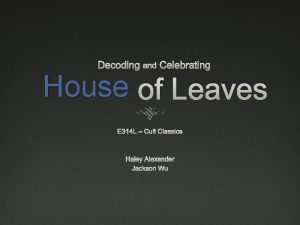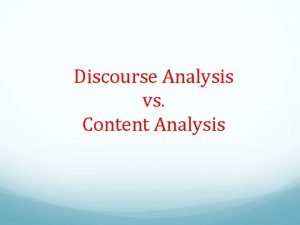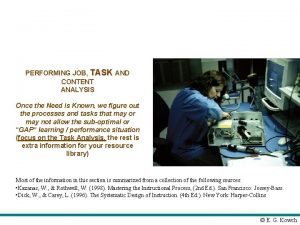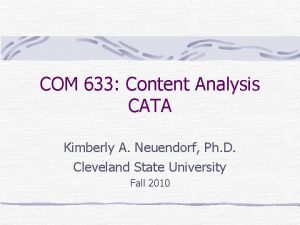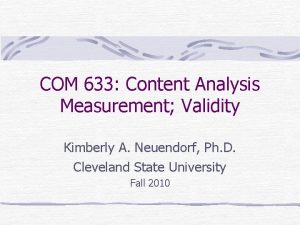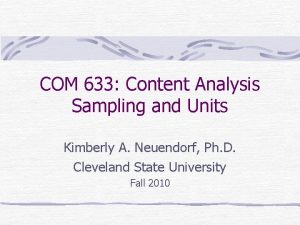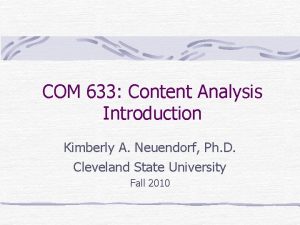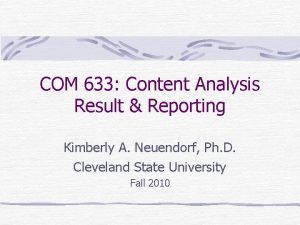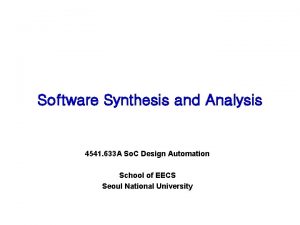COM 633 Content Analysis Humancoded Content Analysis The











- Slides: 11

COM 633: Content Analysis Human-coded Content Analysis; The Coding Scheme Kimberly A. Neuendorf, Ph. D. Cleveland State University Fall 2010

Human-coded Content Analysis Measures: Not So Different from other Quantitative Studies Like survey or experimental measures. . . Exhaustive, mutually exclusive categories High level of measurement Good distributions/transform if necessary May combine into scales

The Coding Scheme Codebook + Coding Form = Coding Scheme See The Content Analysis Guidebook Online for some examples Janstova Thesis example (27 -page codebook)

Patrika Janstova Thesis: Empirical Testing of Auteur Theory via Content Analysis: A Study of Jane Campion Films Sources of theory and variables: Auteur theory (Bazin, Truffaut, Sarris, Wollen & structuralism) Campion films and scholarly literature Other auteurs— 50 Contemporary Filmmakers (Y. Tasker, 2002). . . Every third filmmaker listed

Janstova Thesis: Themes & Motifs for Non-Campion Directors Gregg Araki 1 2 3 4 5 6 Intensifies lighting and color of the city (LA) Love, sex and lust Queer characters Tries to show being gay doesn’t make a difference among people Characters are obsessed with video cameras Adolescents and homosexuality Luc Besson 1 Lack of dialog – comic strip influences? 2 Stories of young people who have difficulties adapting to a society 3 Society lets the family down - the young people become emotionally deprived 4 Youth in crisis 5 Dysfunctional families 6 Parents are absent 7 If mother figure appears – as evil force 8 Protagonists are lonely and suffering 9 Self-erasure of the protagonists 10 Literal portrayals of underworlds – metro, sea, lower regions of cities 11 Characters are “larger than life” 12 Bricolage of genres – more genres in one

Janstova Thesis: Themes & Motifs for Non-Campion Directors Tim Burton 1 2 3 4 5 6 Love for horror and fantasy Plain weirdness of main characters Technical experimentation with possibilities of animation and visual effects Main characters are outsiders villains with extremely complex personalities Main characters have very pale skin Themes of exclusion and inclusion 7 Johnny Depp 1 2 3 4 Kung-Fu stunts Master-pupil theme (comical) Silent cinema feel to some of his scenes (i. e. , chasing scenes, bar fights) Female roles are always over the top girlish 1 2 3 4 5 6 The physical and the psychological are usually intertwined Main character is often male scientist – with a bizarre name Themes: science, disease, aging, invasion, death in literary metaphors Bodily and psychic mutations Hostility towards women – men fear and are jealous of females Womb envy Jackie Chan David Cronenberg David Fincher 1 2 3 4 5 6 7 8 Critiques of today’s society A man alone in the universe Visual translation of feelings of isolation of the characters Wide angles, shallow focus = isolation Muted light and color Psychological and emotional state of American males of 20 th century Decay of American family Females are barely present

Janstova Thesis: Themes & Motifs for Non-Campion Directors Jim Jarmusch 1 2 3 4 5 Alienation of characters Use of jump cuts Characters have no real direction in life Not interested in What? and Why? but How did one character get where he is now. . . Main characters are outsiders Abbas Kiarostami 1 2 3 4 5 6 7 Ang Lee 1 2 3 Challenges the audience Poetic and philosophical style Self-referentiality Social realist traits/themes Bleakness and loss - main themes Often hopeful and enthusiasm accompanies the results Likes to involve the audience as much as possible Modernity vs. tradition Deep secrets and internal torment come to surface Conflict between freedom and societal traditions Michael Mann 1 2 3 Interested in real events Fading centrality of a male Visual: soft blues, and sterile and harsh whites

Janstova Thesis: Themes & Motifs for Non-Campion Directors John Sayles 1 2 3 4 5 6 7 Social concerns Political awareness Complex characters No central protagonist, usually group of characters Stretches the boundaries of genres Witty dialog Realistic characters Steven Soderbergh 1 2 3 4 5 6 Oliver Stone Character based films Ironic humor Sense of isolation and loneliness Characters are harshly detached, emotionally frozen Characters are unable to fit with the world around them – lonely Ultimately, his films are character studies of populated with strangers in a strange land 1 2 3 4 5 Lonely and isolated male protagonist in quasi-spiritual journey Character goes through innocence, suffering and experiences liberation or destruction Testosterone-driven and often didactic dialog Marginalization of women The lure of homo-social is evident 1 2 3 4 Very national – Australian – rather than international Avoidance of sexuality No vivid sex scenes However he shows erotic desire 1 2 3 4 5 Multiple protagonists Teen angst (anxiety, fear, worry) Gangsters Biopic Emotional intimacy and heterosexual love atavistic Peter Weir Allison Anders

Janstova Thesis: Variable Sets & Units Variable Set Unit of Data Collection Themes & motifs Film Narrative constructions Major character Production techniques 5 -minute interval

Janstova Thesis: Sample All 6 Campion films 1989 -2003 18 “matched” non-Campion films Total n=24 films

Janstova Thesis: The Codebook Available at the Content Analysis Guidebook Online (newer version, http: //academic. csuohio. edu/neuendorf_ka/content)




